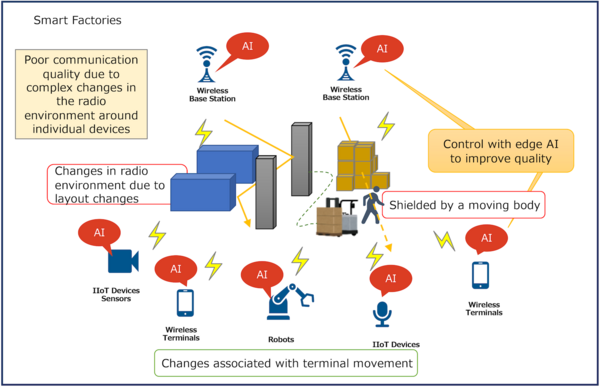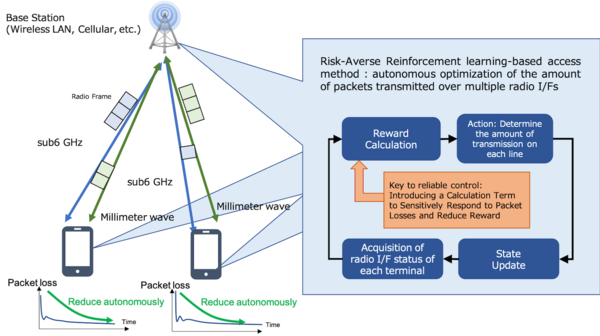News
News Release
Project Selected by JST & ANR for Japan-France SICORP "Edge AI"
Accelerating R&D of AI-based autonomous wireless access control technology
Tokyo - March 18, 2024 - The National Institute of Informatics (NII) and NTT Corporation (NTT) , in cooperation with the CNRS Institut de Recherche en Informatique et Systèmes Aléatoires (IRISA) and Wavely, have been selected through an open call for proposal by the Japan Science and Technology Agency (JST) and by the French National Research Agency (ANR), under the framework of the Japan-France Strategic International Collaborative Research Program (SICORP) for "Edge AI"1. Our selected research project LIGHT-SWIFT2 will give rise to a power-saving, lightweight edge AI technology for jointly exploiting wireless communications and sensing in smart factories.
Through this research, we will develop a lightweight edge AI-based technology that can operate even on small devices and terminals with limited computation and battery capabilities, as well as a deep learning and reinforcement learning-based wireless access technology, stemming from the joint research outcomes we have achieved so far. We will advance research on intelligent wireless access technologies that can learn and adapt to the dynamic fluctuations of the devices' surroundings. In particular, the proposed method will enable high-quality wireless communications even under challenging situations where many terminals need to communicate in an environment where radio channel conditions can degrade rapidly and in a complex manner, due to the effects of moving shelves, pillars, people, and machine tools inside factories.
NEWS Highlights
- NII and NTT's application was selected by JST and by the French ANR for the Japan-France SICORP "Edge AI" research project.
- Through this program, NII and NTT will develop a radio access technology exploiting deep learning and reinforcement learning, and advance the R&D of wireless control methodologies using lightweight edge AI that can operate on small devices with limited capabilities.
- Edge AI-based wireless access control will enable high-quality wireless communications with higher data rate and reliability even when many devices are communicating in a dynamically varying environment, i.e., where the radio channel conditions change rapidly due to shielding shelves, pillars, people, moving machine tools, etc., such as in a factory.

1.Background
In the 6G era envisioned in 2030s, the use of Industrial Internet of Things (IIoT) terminals for factory automation and automated driving will expand, and wireless communications will become paramount for controlling and managing these devices. The quality of wireless communications varies from instant to instant depending on the ambient environment. Given this inherent instability, it is difficult to ensure reliable communications (minimal packet loss and low latency) among many connected IIoT terminals such that they meet strict quality of service requirements. In addition, to control the communications of many IIoT terminals, it is necessary to cope with their surrounding mobile environments that vary independently. Optimizing communications through centralized control poses the challenge of sending and receiving information from a massive number of devices, thereby consuming large amounts of power and bandwidth to manage the wireless access of all terminals in real-time.
2.Key points of the research
In the selected research project, we will develop a high-performance, low-power edge AI technology, namely a "lightweight AI" that can be used even by edge devices such as IoT terminals with low capabilities in terms of computation and battery, with the goal of optimizing their wireless communications and sensing. By doing so, we aim to establish technologies that can achieve stable and reliable communications despite the rapid and complex changes of mobile environments as in factories. Conventionally, it has been common to use base stations and controllers to manage communications in a centralized manner, but the proposed lightweight edge AI will enable many distributed terminals to optimize their wireless access and to rapidly react to the dynamic fluctuations of their mobile surroundings.
NII and NTT will develop a novel radio access technology using lightweight edge AI, building upon the reinforcement learning-based multi-radio access technology that they have designed through their joint research, and accelerate their research towards practical application. In this project, the goal is to reduce the power consumption at edge devices to 1/2, and to reduce the convergence speed of reinforcement learning to 1/2, as compared to the current benchmark method.
3.Multi-radio access technology exploiting risk-averse reinforcement learning
Through this collaboration research, NII and NTT have developed a multi-radio access technology based on the Risk-Averse Q-learning (RA-QL)3 method, one of the advanced reinforcement learning methods. As shown in Figure 2, the proposed RA-QL-based wireless access method reacts sensitively to packet losses of the wireless links. In wireless communications with multiple radio interfaces, the proposed method leverages RA-QL to enable each access point to autonomously select the best interface and the amount of transmit packets, in order to achieve reliable communications. This technology hence enables to control wireless packet transmissions, according to the varying conditions of the mobile environment surrounding each access point and terminal. Through computer simulations, it was confirmed that the target packet loss rate could be achieved for base stations and terminals equipped by radio interfaces over two frequency bands, sub-6GHz and millimeter waves.3 In addition, we have proposed a wireless access method that exploits deep reinforcement learning (e.g., Deep Q-Network) designed for edge AI, namely with a small-scale Deep Q-Network in order to achieve lower processing and energy consumption. These research outcomes have been published in a top international journal of the field.4

4.Roles of each institution
- NII: Design and evaluation of the core algorithm for this technology, represents the Japanese organization of the Principal Investigator (PI) for SICORP (PI: Assoc. Prof. Megumi KANEKO)
- NTT: Discussion on the creation of this technology in the joint research, examination of applicable architecture, and experimental evaluation (co-PI : Dr. Yasushi TAKATORI)
5.Outlook
We will further advance our research on smart wireless access technologies exploiting lightweight edge AI, to provide high-quality wireless communications even when many terminals need to communicate in a complex mobile environment, while realizing large energy savings. Through our selected research project that builds upon these technologies, we aim to further establish practical edge AI-based technologies for future smart factories.
Links
News Release: PDF
*1 JST Press Release #1657 JST and ANR (France) jointly fund three research projects in the Edge AI field under the Strategic International Collaborative Research Program (SICORP) framework
https://www.jst.go.jp/pr/info/info1657/pdf/info1657_en.pdf
*2 LIGHT-SWIFT: LIGHTweight edge artificial intelligence for Sensing and WIreless communications in connected FacTories
*3 T. H. L. Dinh, M. Kaneko, K. Kawamura, T. Moriyama and Y. Takatori, "Improving Reliability by Risk-Averse Reinforcement Learning over Sub6GHz/mmWave Integrated Networks," ICC 2022 - IEEE International Conference on Communications, Seoul, Korea, Republic of, 2022, pp. 3178-3183.
*4 M. Kaneko, T. H. Ly Dinh, K. Kawamura, T. Moriyama and Y. Takatori, "Wireless Multi-Interface Connectivity with Deep Learning-Enabled User Devices: An Energy Efficiency Perspective," in IEEE Network, vol. 37, no. 3, pp. 132-139, May/June 2023.

 Summary of NII 2024
Summary of NII 2024 NII Today No.104(EN)
NII Today No.104(EN) NII Today No.103(EN)
NII Today No.103(EN) Overview of NII 2024
Overview of NII 2024 Guidance of Informatics Program, SOKENDAI 24-25
Guidance of Informatics Program, SOKENDAI 24-25 NII Today No.102(EN)
NII Today No.102(EN) SINETStream Use Case: Mobile Animal Laboratory [Bio-Innovation Research Center, Tokushima Univ.]
SINETStream Use Case: Mobile Animal Laboratory [Bio-Innovation Research Center, Tokushima Univ.] The National Institute of Information Basic Principles of Respect for LGBTQ
The National Institute of Information Basic Principles of Respect for LGBTQ DAAD
DAAD
